Traditional slip prevention methods often fall short because they rely on assumptions and general practices rather than solid evidence, but a scientific approach will identify why they occur and how they can be prevented.
Features
The science of Slipology – how scientific methods can slash the risk of slip accidents this ‘Sliptember’
Despite causing 30 per cent of RIDDORs (Reporting of Injuries, Diseases and Dangerous Occurrences Regulations injury reports) and more than £1 billion of insurance claims year-after-year, slips are not inevitable. What if you could halve your slip incidents using science? It might sound too good to be true, but this ’Sliptember’, I’m diving into the world of ‘Slipology’ to show you how scientific methods can revolutionise your approach to slip safety.
 Photograph: iStock/kynny
Photograph: iStock/kynny
Slipology, the science of understanding and mitigating slip risks, offers evidence-based strategies that can drastically reduce the frequency of these incidents. Typically, clients that implement this approach achieve at least a 57 per cent reduction in incidents, injuries and claims – thereby saving tens to hundreds of thousands of pounds a year.
In this article, I’ll explore the core principles of Slipology, uncover the hidden risks that contribute to slip incidents, and provide you with practical, scientifically-backed steps to enhance safety in your workplace. By the end, you’ll see why embracing Slipology this Sliptember is not just beneficial but essential for creating a safer environment for everyone.
The science behind Slipology
At its core, Slipology leverages data, technology and proven methodologies to tackle the persistent problem of slip incidents. By understanding the intricate factors that contribute to slips and falls, an employer, business or site can implement targeted measures that significantly reduce their occurrence. After all, if you can measure it, you can manage it and you can monitor it. Get the inputs right, and our experience at over 4,000 client sites is that the results take care of themselves.
The importance of a scientific approach
Traditional slip prevention methods often fall short because they are based on assumptions and general practices rather than solid evidence. A sticking plaster for a deep cut. A knife in a gun fight. A scientific approach, on the other hand, allows for a deeper, holistic understanding of why slips occur and how they can be prevented.
By applying scientific methods, we can not only identify the true root causes of slip incidents, but also implement measurable solutions that are both effective and sustainable.
 Christian Harris is founder of Slip safety Services. Photograph: Slip Safety Services
Christian Harris is founder of Slip safety Services. Photograph: Slip Safety Services
“Just stick a sign out, we’ll be fine.” Heard that one before?
Don’t tell that to the family of Stanley May, who, in 2015, was walking through his local Co-Op store in Truro when he slipped, fell, banged his head and tragically passed away. A yellow sign was out: it’s clearly visible in the CCTV footage.
“Signage alone is not an adequate control. Proactive measures must be taken to either prevent floors becoming slippery or precluding public access,” said Cornwall Council after their prosecution for health and safety offences resulted in Co-Op being fined £400,000 – despite the sign being unquestionably present.
 Photograph: Slip safety Services
Photograph: Slip safety Services
Signs don’t prevent, science does. Signs don’t protect, science does.
Evidence-based results
The results of applying Slipology are compelling. For example, Euston train station implemented Slipology principles and saw a 60 per cent year-on-year reduction in slip incidents. Another case study revealed a national health club chain that reduced its slip-related insurance claims by 70 per cent, boosting its annual profit by more than £250,000.
 Credit: Slip Safety Services
Credit: Slip Safety Services
Understanding slip risks through the CHIMES framework
There are six causes of slip risk, which I call CHIMES. The CHIMES framework offers a comprehensive method to identify and mitigate slip risks, ensuring a systematic and thorough approach to slip prevention.
Contamination
Contamination refers to any substance on the floor that can increase the risk of slipping, such as water, oil, grease, dust or semi-solids like food particles. A floor that is 100 per cent clean and 100 per cent dry will not be slippery. But the smallest amount of contamination can make a slip 500,000 times more likely. What contamination is there? Where does it come from? How often does it build up? How much of it can we withstand?
Heel
Heel pertains to the type of footwear used by individuals, which significantly impacts slip risks. It includes considerations of both employee (controllable) and visitor (typically not controllable) footwear. “We provide safety footwear” isn’t enough: did you know that certain types of safety shoes are incredibly slippery in certain scenarios? You need to get into the detail…
Individual
These are the human factors that influence slip risks, including age, gender, physical condition and behaviour. Walking at a normal speed in a straight line is one thing, but any activity such as twisting, turning, carrying, rushing or being distracted can make slips much more likely. What can be done to mitigate these activities?
Maintenance
Maintenance involves ensuring that floors and related infrastructure are kept in good condition and that any wear and tear is promptly addressed. There are three key aspects: change of use, wear and tear and cleaning (the largest part). Most floors are cleaned regularly, often daily. But is this cleaning effective at keeping floors slip-resistant? Often cleaning is based on “does it look ok” aesthetically, whereas Slipology calls for a more robust analysis.
Environment
Environmental factors include external conditions such as weather, condensation as well as the design of the built environment. There’s more rain in Manchester than Madrid, clearly. But how well are your buildings designed in terms of entrance matting (an entrance with 800 people per hour using it should have eight to 10 metres of fixed matting, per Health and Safety Executive guidance), lighting, steps and stairs, ramps and slopes, canopies etc?
Surface
Clearly, a floor surface must be involved for a slip to happen. Some floors are more slippery than others, we can all agree. But in my experience, many slips happen on floors that ‘look safe’ but, when analysed scientifically (for example, with a slip test), aren’t. How confident are you that your floors in areas that get wet or contaminated are safe when wet or contaminated?
 Credit: Slip Safety Services
Credit: Slip Safety Services
Practical steps to implement Slipology
Implementing Slipology involves a structured approach that integrates scientific principles into everyday practices to significantly reduce slip incidents. The process has five steps: Assess, Amend, Advocate, Assure and Affirm.
Introduction to the Slip Prevention Scorecard:
One of the most effective places to start this journey is the Slip Prevention Scorecard. This free online tool allows you to self-assess your current slip risk comprehensively and identify areas for improvement using the CHIMES framework.
It takes approximately three minutes to complete and provides immediate feedback on your performance in each area. Based on your responses, you receive scores for each element of CHIMES plus an overall slip risk score.
Interpreting your Scorecard results:
Upon completing the Scorecard, you immediately receive a detailed PDF report by email highlighting your scores in each CHIMES area. This report includes specific recommendations for improvements based on your current performance.
We offer a follow-up consultation (with me personally) to discuss your results in depth. During this session, we provide insights from similar clients and suggest tailored strategies to address identified risks.
Case study: benefitting from the Slip Prevention Scorecard in the manufacturing industry
A head of safety for a manufacturing business attended one of my ‘Introduction to Slipology’ webinars and decided to give the Slip Prevention Scorecard a go. He received his results, which showed good performance on Heel and Environment, decent performance on Maintenance, but room to improve on Contamination, Individual and Surface.
Anyone that takes the Scorecard gets a one-to-one follow-up session on Zoom with me to run through the report in detail. Having done this, we agreed that a sensible next step would be for a member of my team to visit his facility to conduct some slip testing and do an in-depth review of CHIMES. This would be bundled up into a report with recommendations.
Following the visit, the business implemented various control measures, including: anti-slip treatments for foreseeably wet areas that were slippery when wet, improved cleaning regime, new specification for new/replacement flooring, use of matting in hotspots, more effective training, and eliminating certain staff activities.
Next steps after a Scorecard
As mentioned above, we typically find clients ask us to visit their building(s) to conduct a thorough Slip Safety Survey. This includes using the pendulum slip test, the HSE (Health and Safety Executive)-approved method of measuring how slippery floors are.
With this data, which informs not only Surface, but also Contamination and Maintenance from the CHIMES, you can see if your floors have a one in a million risk or as low as a one in two risk. Yes, it’s possible for a floor to be 500,000 times more likely to cause a slip.
This initial data is the bedrock of preventing slips. After all, if you have a slip-resistant floor, you give yourself a good chance of maintaining safety; if the floor is slippery from the outset, all other control measures need to be close to perfect, and you still may struggle.
Get involved in Sliptember
Sliptember is a month-long campaign every September, focusing on raising awareness about the cost (financial and human) of slips plus the proven scientific prevention strategies that are available.
During this month, I’ll be giving talks for IOSH (Institution of Occupational Safety and Health), IIRSM (International Institute of Risk & Safety Management), NEBOSH (National Examination Board in Occupational Safety and Health) and more. I’ll also be hosting ‘Introduction to Slipology’ webclasses, slip-related Safety Roundtables and slip-related Safety And Risk Success podcast episodes.
I’d encourage you to attend one of the above in September, to get a greater understanding of why slips are a problem and what can be done about it.
The benefits of embracing Slipology
Slips are serious. They are – as you’ll now know – scientific. But they absolutely are also stoppable. If you embrace and implement the Slipology approach, you’ll immediately be able to take proactive, quantifiable steps to reduce risk. And the impact of this is instant. Your building(s) will be safer, as proven by science.
In the longer-run, as experienced by organisations that have walked this path before, you’ll cause less harm, reduce costs for your organisation, but also free up your time (no more regular form-filling and accident investigating) so you can be strategic on safety, not reactive.
Final thoughts
Slips are a significant yet preventable issue in many workplaces. By adopting Slipology and leveraging tools like the Slip Prevention Scorecard, you can make informed, effective changes that drastically reduce slip incidents.
Let’s make this Sliptember a turning point in your slip prevention journey. Together, we can halve slip incidents and create safer, more efficient workplaces for everyone. It’s great to feel safe, but it’s even better to have certainty that the biggest risk of accidents, injuries and insurance claims is under control.
Christian Harris is founder of Slip Safety Services.
Take the Slip Prevention Scorecard:
Connect with Christian Harris on LinkedIn to discover more about Sliptember:



